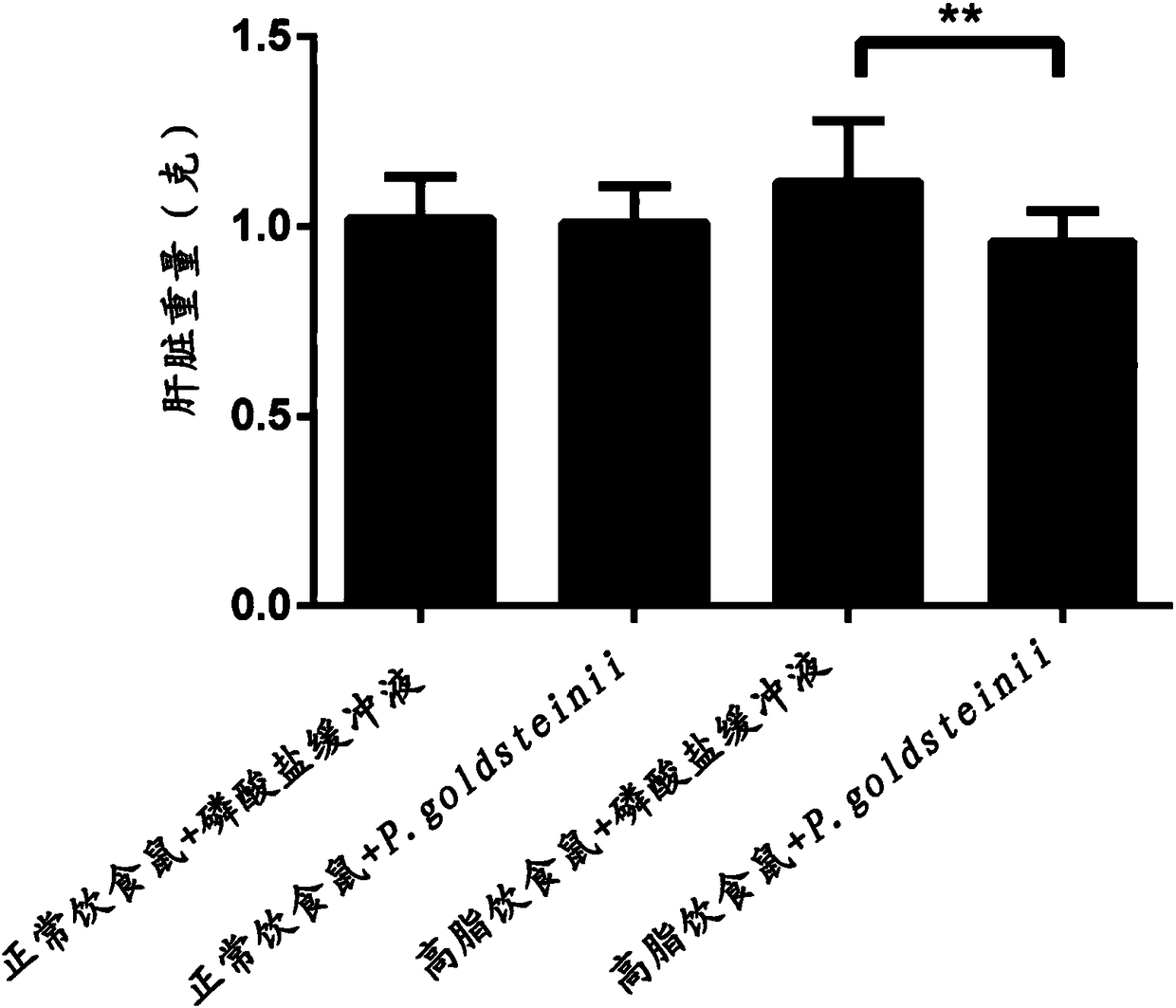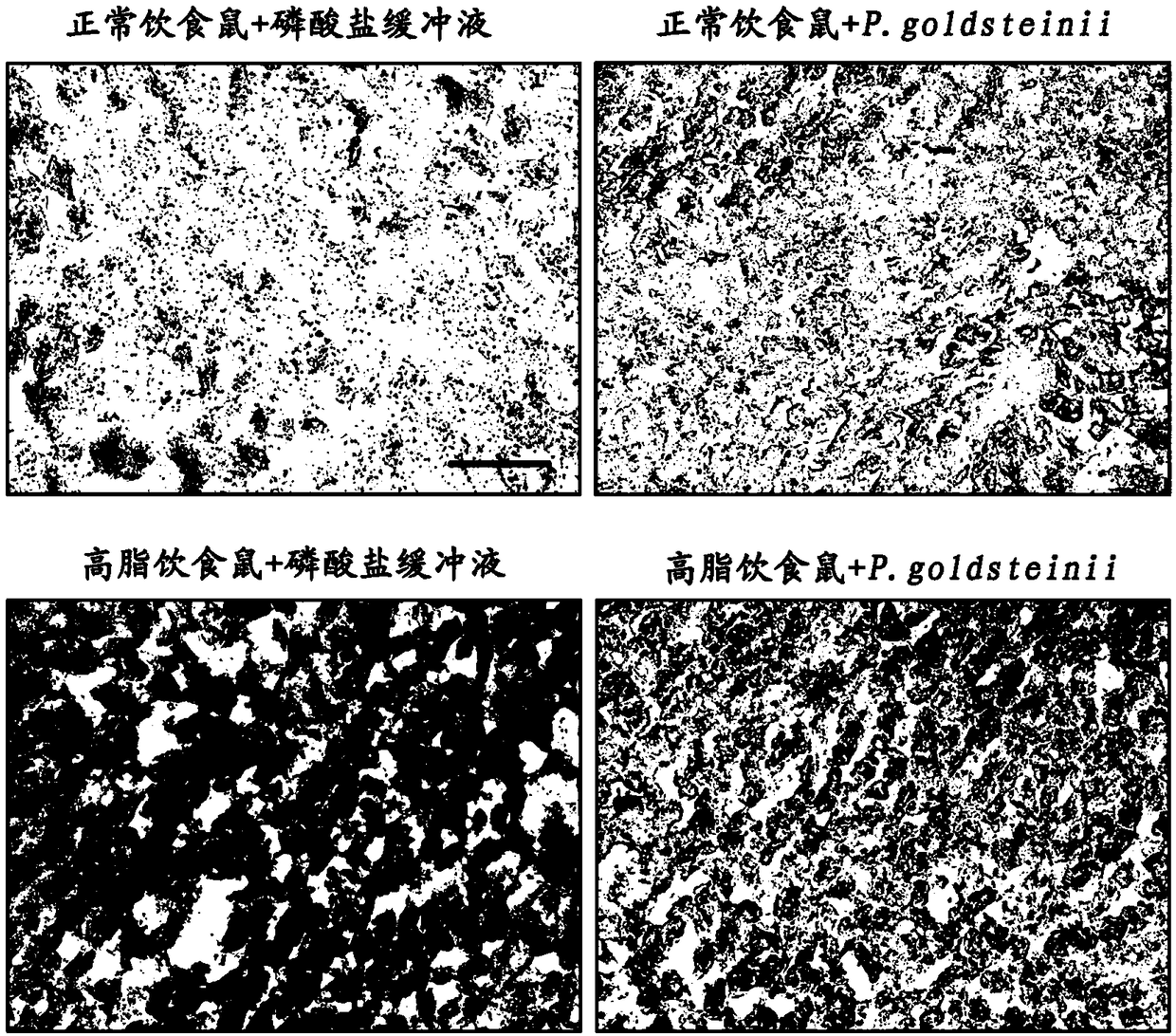Use of parabacteroides goldsteinii to treat fatty liver disease
A technology of parabacteroides and fatty liver, applied in the field of parabacteroides gordii, can solve the problems of bacterial flora change, unclear symptoms and progress, etc., and achieve the effect of weight loss
- Summary
- Abstract
- Description
- Claims
- Application Information
AI Technical Summary
Problems solved by technology
Method used
Image
Examples
Embodiment 1
[0024] Example 1 Effect of Parabacteroides gordii on the content of aspartate aminotransferase in the blood of obese mice induced by high-fat diet
[0025] First, 8-week-old C57BL / 6Narl male mice were divided into normal diet mice fed a standard diet (energy source 13.5% fat; LabDiet 5001, LabDiet, the United States) as a control group, and fed a high-fat diet (energy source 60% % is fat; TestDiet 58Y1, TestDiet, USA) high-fat diet mice were used as the experimental group. Each group was given 200 μl of Parabacteroides gordii ATCC BAA-1180 strain (2×10 6 CFUs) or phosphate buffered saline for 8 weeks (n=10, representing 10 mice in each group). The aforementioned groups of mice are marked as normal diet mice+phosphate buffer saline, normal diet mice+P.goldsteini, high-fat diet mice+phosphate buffer saline, and high-fat diet mice+P.goldsteini.
[0026] After feeding for 8 weeks, detect the aspartate aminotransferase content in the blood of every group of mice with biochemical ...
Embodiment 2
[0028] Example 2 Effect of Parabacteroides gordii on liver weight of obese mice induced by high-fat diet
[0029] Prepare 8-week-old C57BL / 6Narl male mice as in Example 1 above, divide them into groups and feed them, and each group is also normal diet rats+phosphate buffer saline, normal diet rats+P.goldsteini, high-fat diet rats+phosphoric acid Saline buffer, and high-fat diet mice+P.goldsteini.
[0030] After feeding for 8 weeks, the livers of mice in each group were taken out and weighed, and the results were as follows: figure 2 shown. The data of the experimental results are shown as the mean ± standard deviation, and statistical analysis was performed with one-way ANOVA and Bonferroni post hoc test (**<0.01).
[0031] See figure 2 , figure 2It is a graph showing the effect of Parabacteroides gordii in the embodiment of the present invention on the liver weight of obese mice with normal diet and high-fat diet. It can be seen from the figure that compared with the ...
Embodiment 3
[0032] Example 3 Effect of Parabacteroides gordii on Fat Accumulation in Obese Mice Induced by High Fat Diet
[0033] Prepare 8-week-old C57BL / 6Narl male mice as in Example 1 above, divide them into groups and feed them, and each group is also normal diet rats+phosphate buffer saline, normal diet rats+P.goldsteini, high-fat diet rats+phosphoric acid Saline buffer, and high-fat diet mice+P.goldsteini.
[0034] After feeding for 8 weeks, the livers of the mice in each group were taken out and frozen, sliced at a thickness of 6 μm, and stained with Oil Red O (Sigma, USA). is 100μm, the result is as image 3 shown.
[0035] See image 3 , image 3 It is a sliced image of fat accumulation in the liver after Parabacteroides gordii in an embodiment of the present invention acts on obese mice fed a normal diet and a high-fat diet. It can be seen from the figure that compared with the normal diet rats, the fat accumulation of the high-fat diet rats increased a lot after 8 week...
PUM
 Login to View More
Login to View More Abstract
Description
Claims
Application Information
 Login to View More
Login to View More - R&D
- Intellectual Property
- Life Sciences
- Materials
- Tech Scout
- Unparalleled Data Quality
- Higher Quality Content
- 60% Fewer Hallucinations
Browse by: Latest US Patents, China's latest patents, Technical Efficacy Thesaurus, Application Domain, Technology Topic, Popular Technical Reports.
© 2025 PatSnap. All rights reserved.Legal|Privacy policy|Modern Slavery Act Transparency Statement|Sitemap|About US| Contact US: help@patsnap.com



